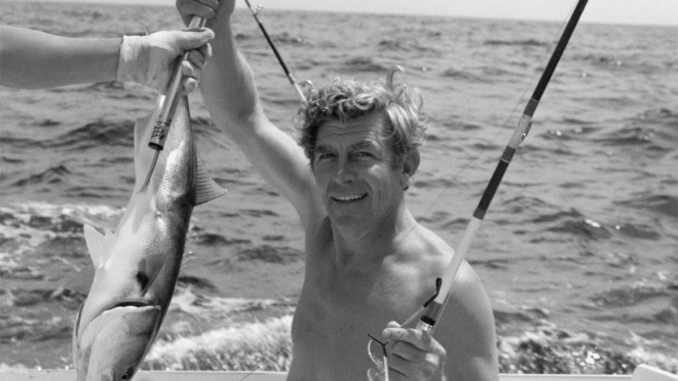
On a balmy August 2020 sunset, as the last light of day faded over Roanoke Sound, I was invited by island friends to board their 30-foot wooden sport fishing boat, which had carried Andy Griffith when he was too weak to operate his own.
They told me of the times they had shared drinks with Andy on the water, sharing stories about him with pride and affection. We left the dock in downtown Manteo, gliding gently across Shallowbag Bay, then slowly north past the sandbar where Andy moored his pontoon with friends to play volleyball, an activity he loved because he hated being alone.
We passed Andy’s last home, tucked away in the pines, near the Waterside Theatre, where he began his acting career in the summer of 1947 with the outdoor play The Lost Colony.
Throughout his six-decade career, Andy has returned to the island, which he considers his true home. He often flies back from Los Angeles, then takes a small plane to the island, where the ocean and pine forests always make his heart flutter.
2022 marks the 10th anniversary of Andy’s death (July 3, 2012). Fans everywhere still wonder: What was Andy really like? He often said he was nothing like Sheriff Andy Taylor – the character named after him in the famous series – but there was clearly a bit of the real Andy in there.
Close friends on the island, after years of silence, began to share about Andy. They described him as a man full of contradictions: a good shot, a strong drinker, but also deeply religious in his own way; a lover of the slow island life, often gathering with friends to play guitar and drink beer; generous and frugal; always helping the underdog; sometimes naive but also curious and optimistic.
Andy was also known for his pranks, like the time he tricked a friend into eating a sandwich of horse manure as a hamburger. He loved cars, collecting and driving vintage cars, although he was not a good driver because he was often too absorbed in sightseeing. Although he sometimes used inappropriate language, he always stood up for his gay friends against homophobic preaching.
He could party all night but also diligently read the Bible, sometimes on the same day. He was a choir director at Mount Olivet United Methodist Church in Manteo. Sometimes he would dock at the Drafty Tavern bar to buy pizza and beer, then sing “When the Saints Go Marching Out” with his friends, a humorous version of the famous hymn.
Andy was a gifted comedian and sometimes a brilliant dramatic actor, but he rarely left a public writing. He was obsessed with the power of stories. His breakthrough role in 1957’s A Face in the Crowd forced him to confront his own dark side – an experience that director Elia Kazan and co-star Ron Howard said left a lasting impression on him.
When Andy arrived on Roanoke Island in 1947 to star in The Lost Colony, he was a young, energetic man eager to learn from the locals and his co-stars. He absorbed the islanders’ adventurous spirit, which led him to Broadway and Hollywood.
The islanders accepted him, giving him a sense of belonging that he had lacked in his hometown of Mount Airy. He never forgot that and was always willing to help them in times of need, from arranging flights for a friend with cancer to singing at a friend’s wedding.
Andy incorporated the lessons he learned from the island into his television show. “If Mayberry is anywhere, it’s Manteo,” he once told author Angel Ellis Khoury. Although Mount Airy hosts the annual Mayberry Days festival, Andy always considered Manteo to be the true inspiration for Mayberry – a place that values friendship, tolerance and healing humor.
As he rose to stardom, Andy did not forget his roots. He became actively involved in Manteo preservation and development, from founding the Outer Banks Community Foundation to opposing big box stores to protecting local businesses. He also helped bring free internet to island students.
Although he maintained a home in California, Andy always called Roanoke Island home. He met his first wife and his third wife – who would be with him for the rest of his life – through The Lost Colony.
Every summer, he would moor his boat near the Waterside Theatre, walk backstage barefoot to encourage the young actors, and then quietly leave before the show started, not wanting to steal their spotlight.
Andy inspired many, including actor Leon Rippy, who would later become famous for his roles in The Patriot, Saving Grace, and Deadwood. To the people of Manteo, he was the embodiment of cool, success, and hometown loyalty.
Like many other Southern artists such as Hank Williams Sr., Jerry Lee Lewis, and Johnny Cash, Andy was torn between his dream of paradise and his obsession with the land.
Safe in the full range of the domain. He dreamed of becoming a Moravian minister, then spent much of his career working and playing hard, before returning to gospel albums and daring roles, attracting a new generation of fans.
Before his death, he gave up hard liquor but continued to drink white wine in moderation. He renewed his faith at a small church near Roanoke Sound. He has been honored by North Carolina governors, presidents, and The New York Times.
Andy’s journey from poverty to television stardom is a testament to his strength and gratitude. He was serious about making people laugh and always looking for ways to make the island that made him. That was Andy – the real thing, all its complexity and sincerity.
John Railley’s Andy Griffith’s Manteo: His Real Mayberry is a profound work, revealing the real Andy Griffith through the stories of his closest friends on the island. The book is available on Amazon, Barnes & Noble, and e-platforms like Everand.

